To celebrate the release of KSHMR’s newest and biggest sample pack release ever, we at Splice decided to challenge ourselves.
We (Exitpost, Rewak, and Cuttle) set out to make tracks entirely out of samples from “Sounds of KSHMR Vol. 3,” all in under 30 minutes, all in different genres. Thankfully, the pack is chock-full of endless creative inspiration. Here’s what we made.
Ambient trap / downtempo electronic by Exitpost
For this track, I wanted to create a hard-hitting beat with lots of ethereal textures and ambience. I wanted to also only use audio samples, so there’s no additional VST work and very little effect processing in my track.
Synths
I started by creating a nice bed of atmospheres, using one of the Song Starters in KSHMR’s kit. There was a really nice sidechained synth pattern with lots of movement. I built on that and began layering additional melodic lines and sounds to create a nice environment the rest of the song could live on. I used two drone samples to give the track a basis of a chord progression with the root notes being the notes in the drones. I applied very little effect processing on these, just some Logic stock reverb and a little tremolo here and there.
To add a bit of a build up, I layered a snare fill from the KSHMR pack and a cymbal crash, which I reversed. Simple additions like risers and snare fills before a drop can give the tension and release and dynamic change that will make a drop feel more like a ‘moment.’
Drums
For the drop, I knew that I wanted to keep things simple, so I started by putting down a pretty straightforward kick and snare combination. Varying up your kicks also creates some interesting percussive ideas, and because this track is a hip hop instrumental, I chose to offset the snares from the grid a bit to provide some swing and a human touch to the drums. I used hi-hat loops and subs from the pack, in addition to some percussive layers (snaps, foley, impacts, etc.) to add some more bounce to the song. Some risers and build-ups also gave the track the tension it needed at parts.
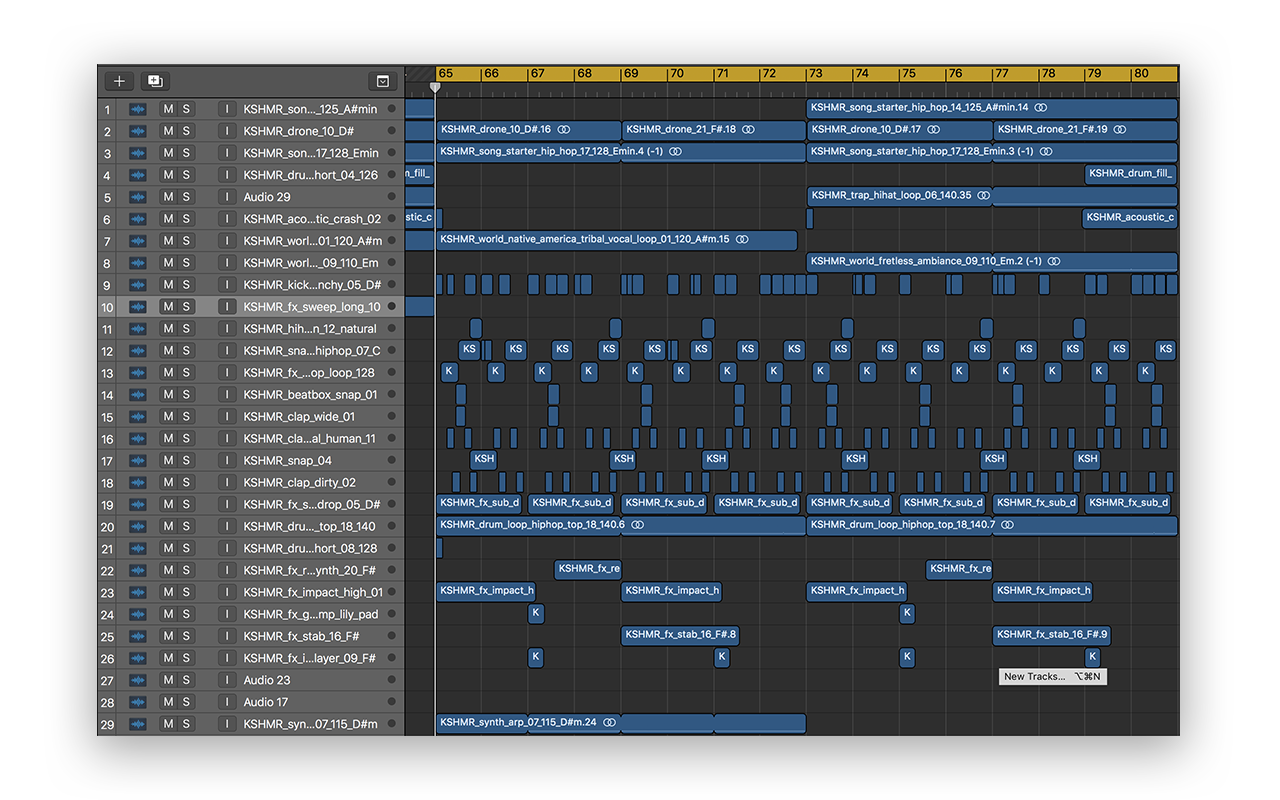
For the bridge, I simply left the ambient layers behind and introduced some other melodic elements. Most of the track is just adding and subtracting different layers and varying up the drums in unique ways.
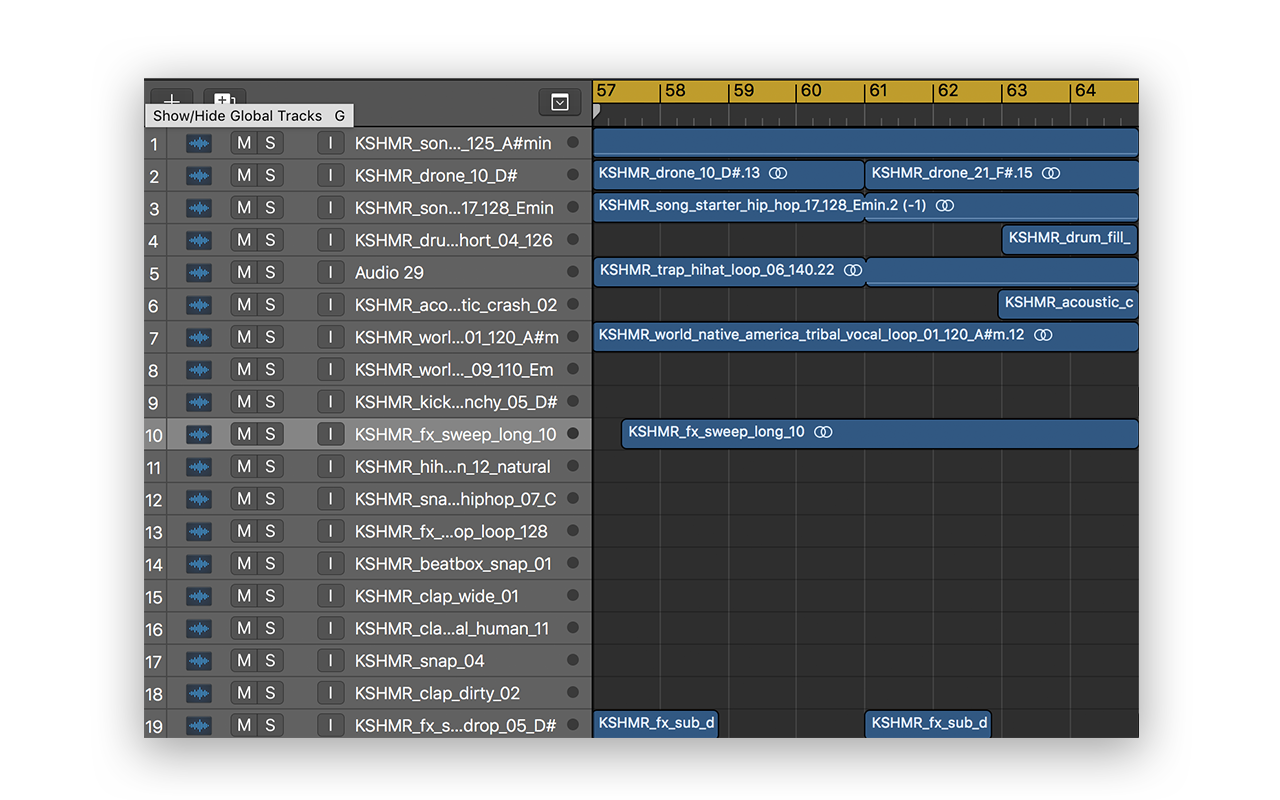
Melbourne Bounce / EDM by Rewak
I first heard of KSHMR as part of production group The Cataracs, but he’s arguably better known now for his enormous big room house, EDM-style tracks. This genre popped into my head immediately when I heard this first sample, even though it’s actually a hip hop sub bass stem at 140 bpm.
Bass
I love this sample’s expansive sense of movement, but the wavy sustained notes were a little bit low-energy for this style, so I chopped the sample up to emphasize the repeated quarter-note hits. I also added a bit of extra flair by reversing select bits of audio to create a sweep effect going into the next measure.

I tried to filter out the mids and highs, but the sample became a bit boring as a result. So, I’ve sidechained the filter’s cutoff frequency to a four-on-the-floor ghost kick, which will mirror the kick pattern I’m about to introduce.

Drums
I spent a little too much time working on the lead sound, so these drums are super basic. Basically, we’ve just got a four-on-the-floor kick and clap on top of it, then a ride layer over that starting on measure 9.
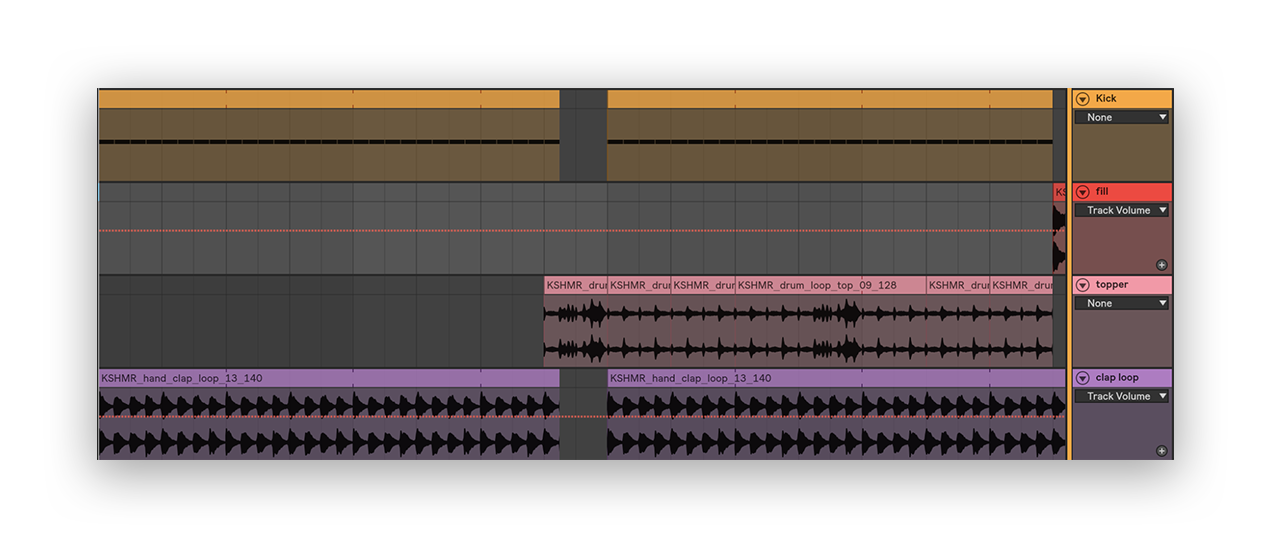
It’s a little cookie-cutter, but to be perfectly frank, this genre isn’t really known for complex polyrhythms or intricate drum sequences. It’s all about that big kick right in your face, and the percussion layers help add energy to the already-huge kick sample I used for this track. That said, if I had more time, my first priority would be to put a little more work into the drums.
Lead
When I think about iconic Melbourne Bounce tracks, I think immediately of Martin Garrix’s “Animals.” I made a loving reference to this track by using this sample in lieu of a synth lead here.
I’ve used a return track to give this slappy metal percussion hit its character. A nice big reverb, sidechained again to the ghost kick, makes for a spacey, wide lead while preserving the transient punch of the original percussion sample.

Dubstep by Cuttle
For this track, I wanted to reimagine the deeper and more classic dubstep sound using some of the pack’s lush percussion recordings and textures along with some snappy drums. The initial idea was to create a minimal yet catchy groove with an immersive atmosphere behind it – think late night warehouse vibes.
Lead
I started things off with one of KSHMR’s koto samples, a multi-note riff that I chopped up into shorter phrases and pitched down an octave. Add some delay and you’ve got yourself a dark motif that anchors the identity of the track.
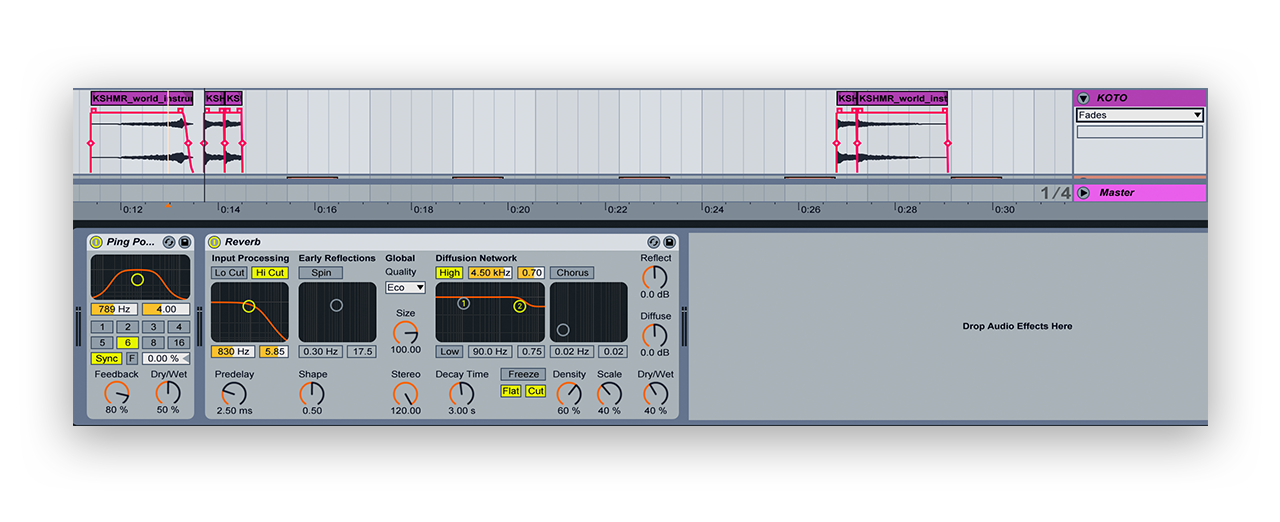
Drums and percussion
After creating a relatively simple drum pattern with a punchy kick and two of KSHMR’s snare hits, I grabbed a 140 bpm percussion loop and chopped it up to fill in the missing space in the rhythm. The result is a bouncy, cyclical groove that you can keep looping for days.
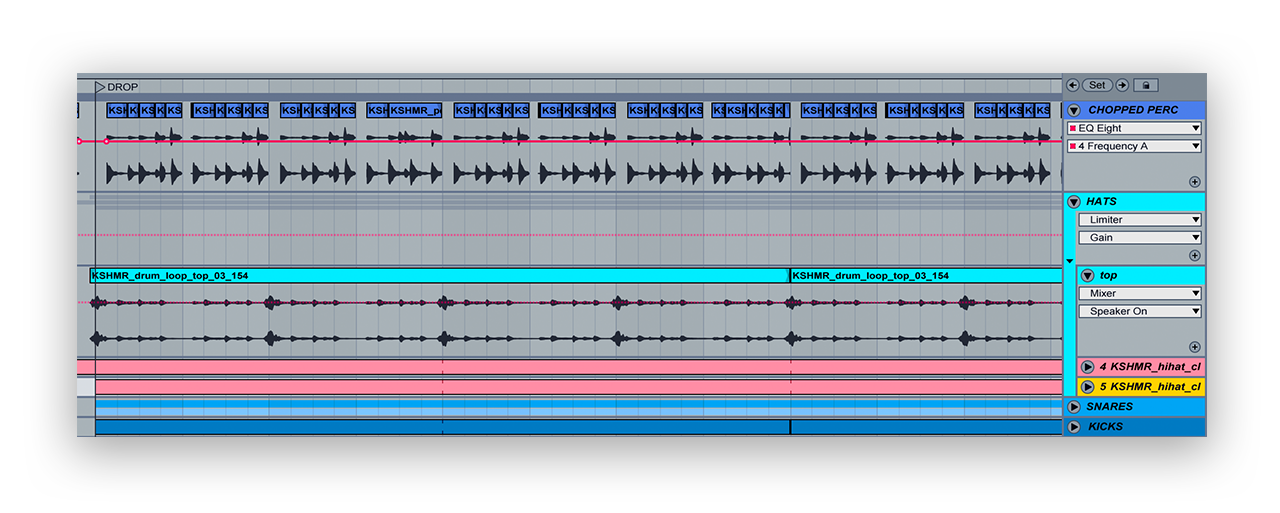
Bass
The bass consists of a single long sub drop sample at the start of each phrase, and punctuated with some of KSHMR’s growling bass one-shots (enhanced through auto panning and a bit of reverb). I placed these at the start and end of each phrase to coincide with the koto and help maintain the overall energy of the track.

Lo-fi hip hop by Exitpost
Are you even a millennial digital native if you haven’t logged study hours zoning out to 24/7 Study Beats and Chill? Understated, nostalgic, and wonderfully cozy sounding lo-fi hip hop is in, so let’s see what we can do with KSHMR’s pack and a little bit of creative mixing.
Guitars
We’ll be using a nice little guitar arpeggio sample as a central element in this track. Since we’re making a lo-fi hip hop beat, we’ll want to make something in the 70-100 bpm range, so I used Logic Pro’s Flex function to slow this sample down to 90 bpm. We’ve then added a bit of EQ, reverb, and low end accentuation to create an irresistible warmth.
Here are the effects rack settings I used:

Drums
A big part of making something sound ‘lo-fi’ is stripping the track of its higher frequencies (think of it like playing the track on an old busted tape player or something). The way we’ll achieve this is by stripping most of the high end using a single band EQ and adding a little bit of warmth and grit via a slight distortion. I created a pretty simple snare, kick, and hi-hat rhythm using sounds from KSHMR’s pack. Displacing the snares just slightly off the grid will create a nice syncopation.
Here’s my effect rack for the snares:
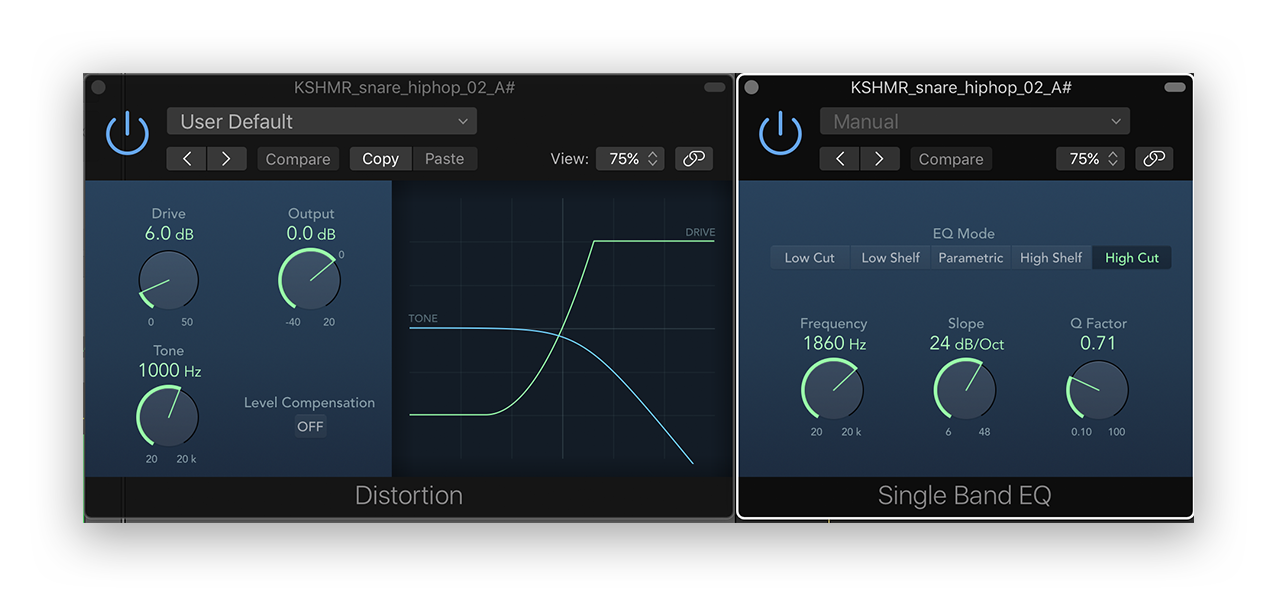
Here’s my effect rack for the hi-hats:
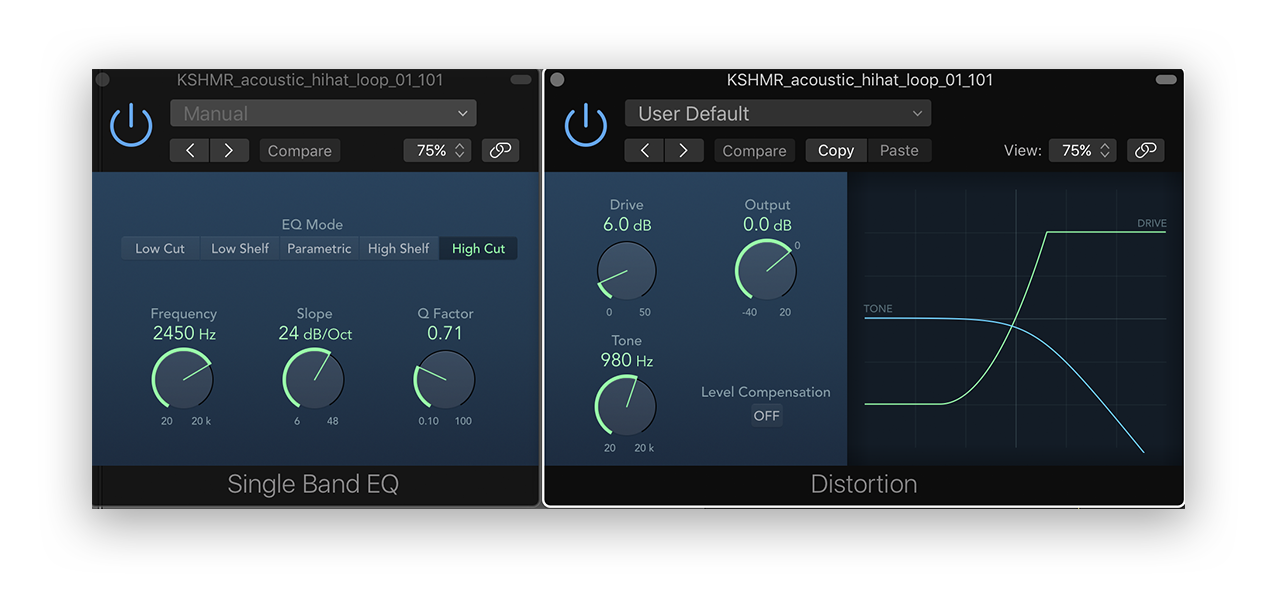
Here’s my effect rack for the kicks:
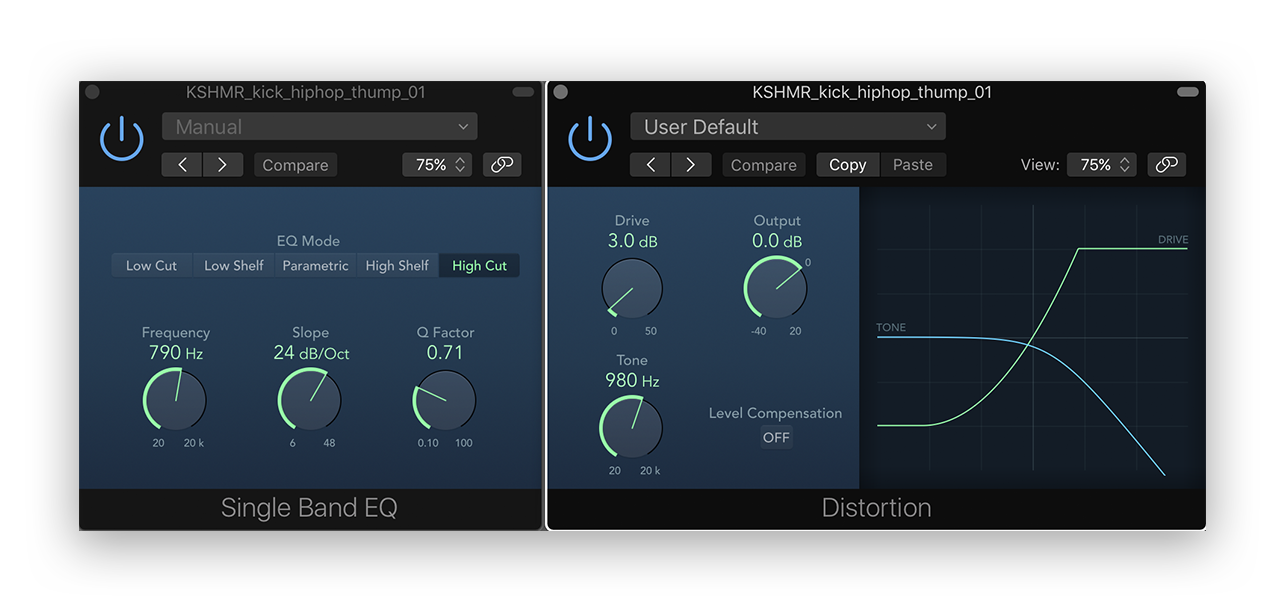
Trap by Rewak
I was immediately inspired by this sample.
What a cool haunting vocal – and I love the accent from that building arp. The syncopated synth percussion stabs are great too, and really imbue the sample with a sense of movement. This sample is so well-layered that it serves as a great bed for the rest of the track. All I did was make a duplicate and pitch it down an entire octave, then reduce the gain and high-pass filter the original sample.
Some Fula samples add additional melodic touches. Specifically, I was drawn to the plucked quality of the attacks found in this sample. But I wanted to really create that smoked-out, hazy effect you sometimes find in some trap beats, so I found another Fula sample with a little more body, pitched it down, and drowned it all in reverb. The result is a beautiful mess:
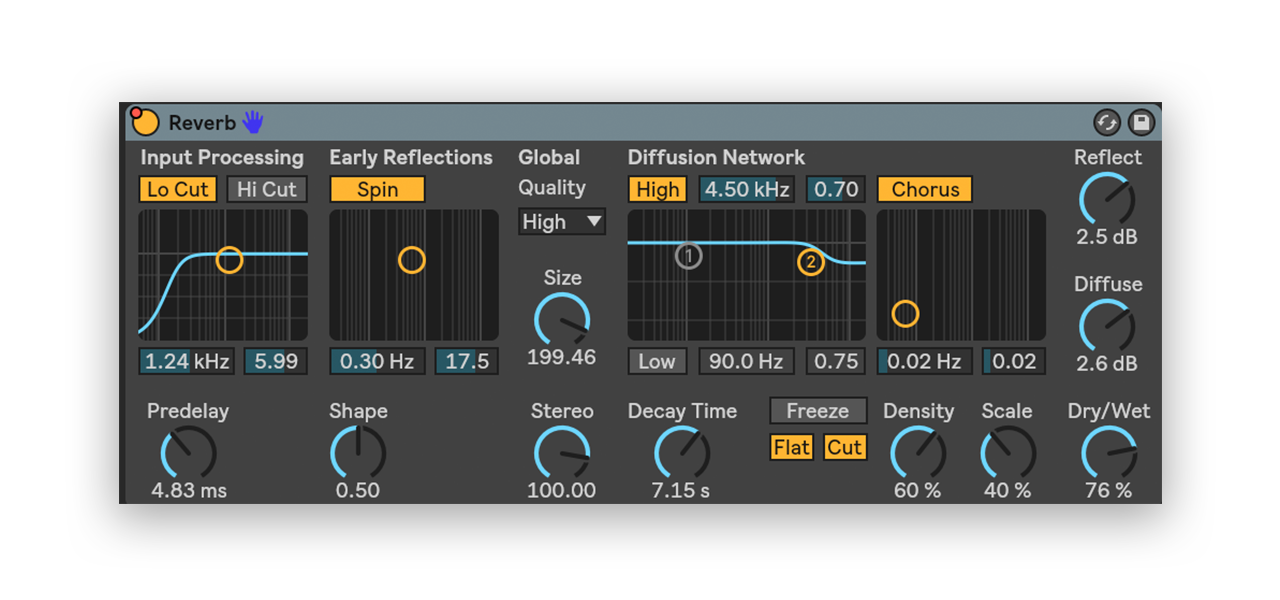
To keep this reverb from getting too out of control, I used a tip I saw in a previous KSHMR tutorial video. Basically, this involves automating the reverb off after each quarter note attack.
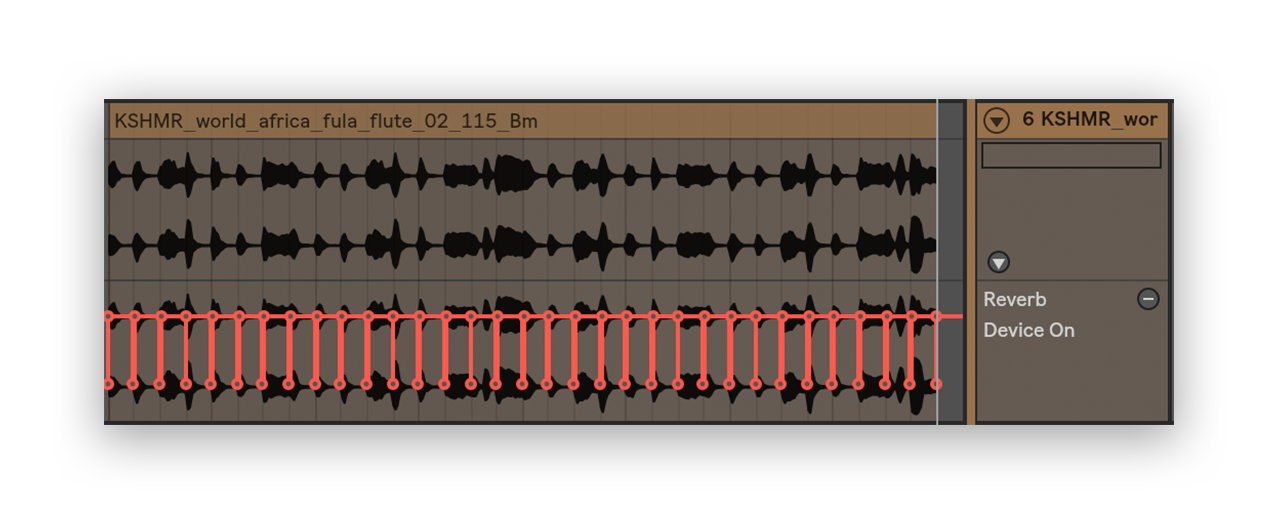
Thanks to this technique, I was able to achieve an extremely wet sound, but the reverb’s tail won’t linger into the next melodic phrase and cause dissonance.
Drums
Once again, these drum patterns aren’t much to write home about. Pitched-down hats playing straight eighth notes are mostly standard for the course for a lot of trap music. Still, I had a lot of fun playing around with tiny chops and accents on the open hat samples. Try experimenting with different pitches – it really adds a layer of intrigue to the sequence.
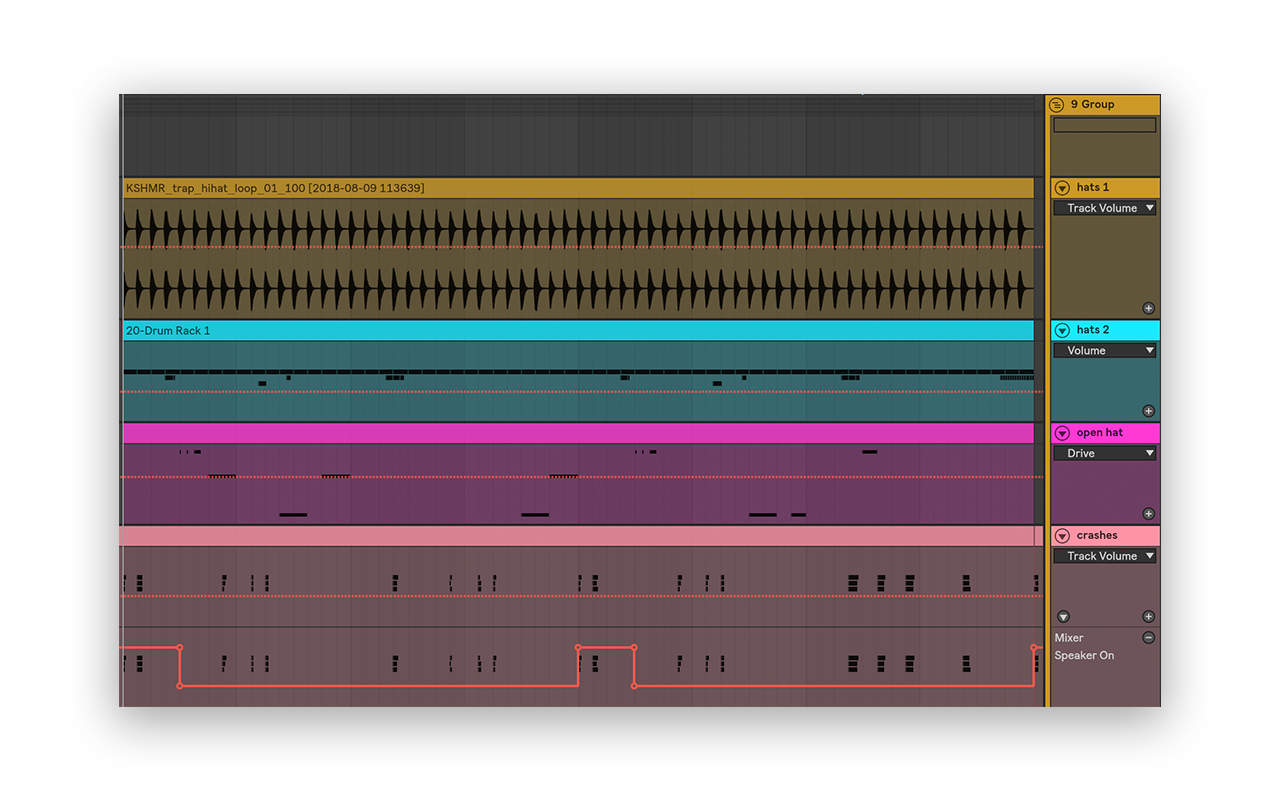
Bass
Easily the most fun part of this beat to create – I began with a huge hardstyle kick sample, then distorted it like crazy.

By looping the sample, I created a distorted, high-pitched bass layer that can be sustained throughout the relatively long amplitude decay time.

The low layer is meant to give body to the bass. It’s still warmed up a tad by the Saturator, but it’s far less distorted than the hardstyle kick. If I had some more time to work on the track, I’d work on the EQ to make sure these fit together a little nicer, but for now this is a really nice aggressive trap sub-bass.
8 bit / organic by Rewak
I’m constantly inspired by the interplay between humans and their technology. One of my favorite techniques is to take a live sample, then use Ableton to extract the MIDI from it. It’s not usually perfect, but the artifacts and mistakes generated by the DAW’s analysis algorithm can be very compelling, so that’s how I chose to process this guitar sample.
With the help of a few reverb tricks from the KSHMR video I linked above, this becomes an instantly head-noddable lead melody. I took the MIDI that Ableton generated, cleaned it up a bit, and came up with something like this:
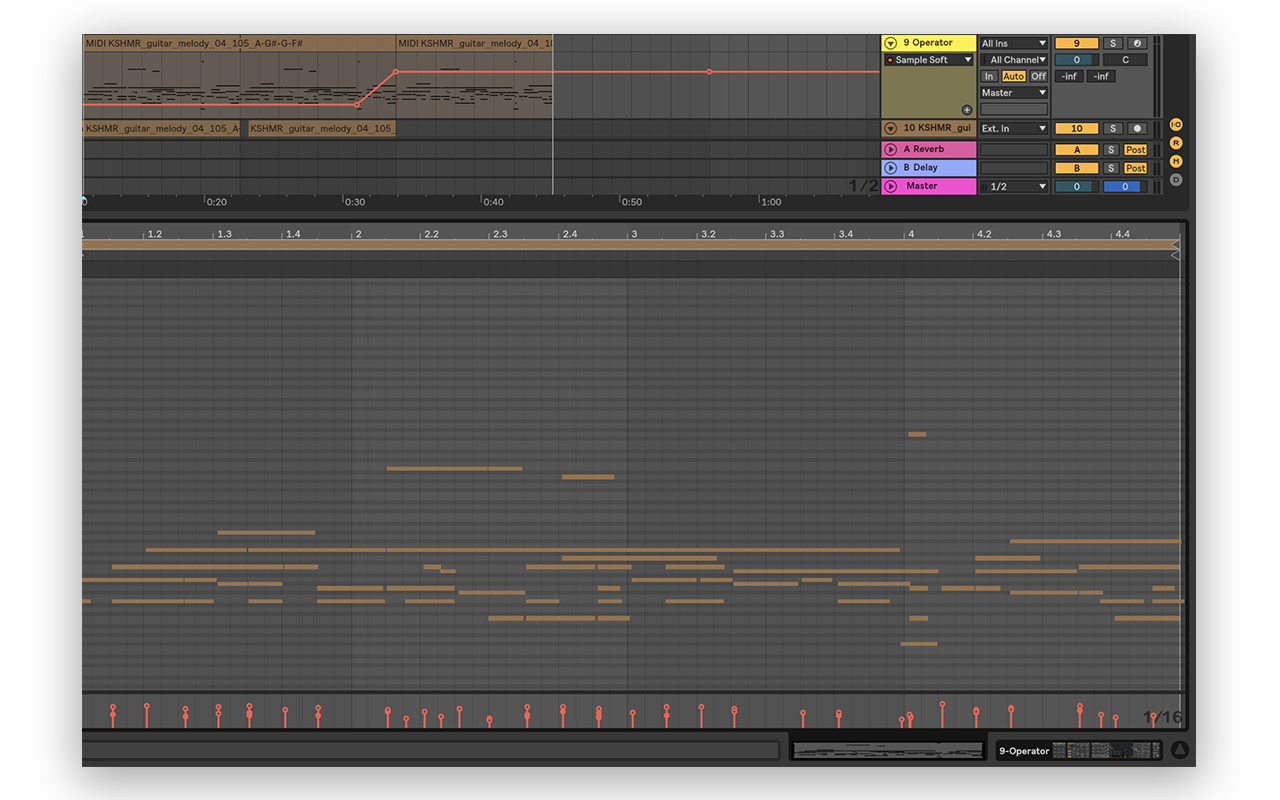
Instead of just playing chords, though, I made a really simple triangle Operator patch and added Chord and Arpeggiator MIDI effects:

This bitcrushed arp gives my composition some 8 bit flavor. I think it’s a really nice juxtaposition with the very organic guitar, but I spent way too much time on it so I had to move on.
For one final melodic touch, I copied the MIDI chords into a new track and loaded up a sampler with this sample. I really love the way this sounds – it’s like a weird violin choir playing unnatural stabs – but there’s still something noisy, organic, and compelling about it.

Drums
The percussion on this beat is, once again, really simple. I spent most of my time playing and replaying the kick pattern because I didn’t feel like I had truly nailed the pocket of the groove.

I layered a closed hat and a percussion sound to make really beautiful high snappy claps, but if they were just offbeat a little bit more, they’d be a little funkier. For placeholders, I just looped one half-measure of claps to get them on 2 and 4.

Drum & bass by Cuttle
This one actually came together really quickly, due in large part to some awesome breakbeat loops from KSHMR. I built up the intro using a melodic Song Starter loop along with a simple breakbeat, keeping in mind I wanted to switch to a much more aggressive rhythm for the drop. I was actually expecting to do a lot of chopping and editing on the drum loops from the pack to keep the energy levels high, but the main break I used was already so crisp and dynamic that I just dropped it right into my arrangement and moved on. The same goes for the percussive top loop, which I kept throughout the entire track.
I chose to remove any melodic elements from the main drop in favor of a full-on sonic assault. Hollowed-out bass stabs, lasers, modulated dub sirens, vinyl backspins – searching for these fun effects to fill out the main section was easily the most fun I had using the pack. Being able to work with such high quality audio files makes a huge difference in terms of how quickly you can get your ideas out of your head and into your DAW. Overall, there was a lot less mixing and technical work involved in creating these tracks, which meant I could focus more on exactly how I wanted my music to “feel.” And for that, KSHMR, I salute you.
What will you create with KSHMR’s pack? He wants to hear – enter the KSHMR Song Starters Challenge.
Explore royalty-free one-shots, loops, FX, MIDI, and presets from leading artists, producers, and sound designers:
August 24, 2018


